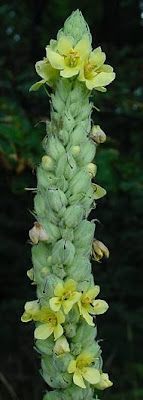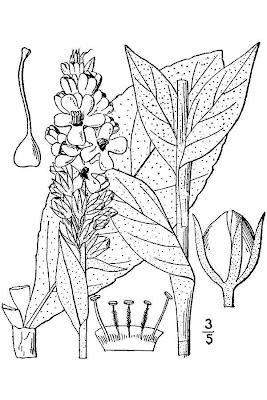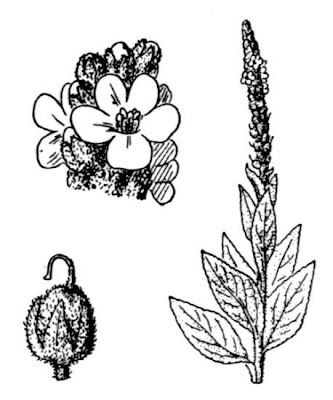Huge roadside Mullein, 2009
Natural colors can be found in under appreciated road-side plants such as Mullein. Although considered a weed by some, I have been enchanted with the naturalized Verbascum thaspus for many years. When boiled the the soft, thick, flannel textured leaves unlock a yellow to grayish green color. Mullein is statuesque and a wildly charming biennial, deserving of a spot in any garden and dye pot.
Scientific Name: Verbascum thaspus, V. blattaria
Common Names:
Mullein, Great Mullein, Flannel Mullein, Flannel Plant, Moth Mullein, Woolen Blanket Herb, Velvet Leaf, Cow’s Lungwort, Candlewicks, Velvet Dock, Bunny Ears
Common Names in Other Languages:
French: molene
Spanish: guardalobo
Potuguese: verbasco
Family:
Scrophulariaceae, Figwort Family
This Family also includes Indian Paintbrush and Penstemon.
Russian: Korviak visoky
Italian: Verbasco Tasso-barbassoFrench: molene
Spanish: guardalobo
Potuguese: verbasco
Family:
Scrophulariaceae, Figwort Family
This Family also includes Indian Paintbrush and Penstemon.
For full taxonomy see:
http://luirig.altervista.org/schedeit/pz/verbascum_thapsus.htm
Description:
Mullein is an herbaceous biennial plant growing from 1 foot to a towering 7 feet tall! During its first year of growth it is developing its root system and the leaves form a rosette of furry, soft, velvety leaves that are silver green. The slender, upright stem shoots from the center of the rosette during the second year of growth. This erect flower stalk forms 5 petaled yellow flowers the entire length of the stalk, producing from June- September in North America. The tiny fruits are round capsules that develop on the stalk. The leaves are simple, meaning that the leaf is a single blade and not divided into leaflets. They are also alternate at the base of the stem and hairy which helps the plant protect itself from insects and moisture loss in hot, dry climates.
http://luirig.altervista.org/schedeit/pz/verbascum_thapsus.htm
Description:
Mullein is an herbaceous biennial plant growing from 1 foot to a towering 7 feet tall! During its first year of growth it is developing its root system and the leaves form a rosette of furry, soft, velvety leaves that are silver green. The slender, upright stem shoots from the center of the rosette during the second year of growth. This erect flower stalk forms 5 petaled yellow flowers the entire length of the stalk, producing from June- September in North America. The tiny fruits are round capsules that develop on the stalk. The leaves are simple, meaning that the leaf is a single blade and not divided into leaflets. They are also alternate at the base of the stem and hairy which helps the plant protect itself from insects and moisture loss in hot, dry climates.
Emerging Mullein Stalk, 2009
Related species and Cultivars:
Verbascum contains about 250 species, most are biennial and some perennial. Try some of the following Verbascum cultivars and hybrids and discover various yellows within Verbascum species. All of them vary in size and leaf color and will be a beautiful addition to any garden:
V. chaixii: nettle-leaved with long arms extending from main stalk
V. phoeniceum: purple mullein
V. bombyciferum: tall with large wooly leaves
V. thapsiforme: flowers
V. olympicum: native to Greece and Turkey
V. creticu: large, lemony yellow flowers
V. blattaria: slender spires, often called moth mullein
V. dumulosum: furry and little
V. bombyciferum: tall with large wooly leaves
V. thapsiforme: flowers
V. olympicum: native to Greece and Turkey
V. creticu: large, lemony yellow flowers
V. blattaria: slender spires, often called moth mullein
V. dumulosum: furry and little
Habitat, Ecology and Distribution:
Mullein is native to Europe, Asia, North Africa and the Mediterranean Basin. But, it has naturalized throughout North America, especially Verbascum thaspus. Although Mullein is adapted to a wide variety of soils: poor and dry, acid or alkaline it does not like “wet feet” and requires a well-drained location to thrive. Due to the hairy nature of its leaves, mullein is rarely disturbed by wild or domestic animals.
Often found in “waste sites” like roadsides, clearings, overgrazed pastures and other disturbed habitats, Mullein can grow as a single statuesque plant or in stately looking localized populations.
Mullein grows best in full sun but it can tolerate part shade in some locations.
Garden Cultivation:
Although there is a taproot on the plant it transplants pretty easily. Mullein can be propagated by seed, the hybrids or cultivars must be divided from root cuttings or division. It is most easily grown from seed and especially volunteer seeds, which begins to germinate underground throughout the fall and winter. Surprisingly, it seeds itself rather sparingly and ends up in unexpected places in the garden-the beauty of letting the garden make its own decisions.
Mullein makes a great addition of “wild charm” to any cultivated garden and requires nil maintenance. Usually it is grown for its large but subtle gray, silvery foliage. Its added surprise is a stately stalk which emerges in the second year of growth. Some other Verbascum species send out multiple stems or arms from the central stalk.
Although rich in history, tradition and folklore there still remains few references about Mullein and its qualities as a natural dye plant. There may be a couple reasons for this obscurity; most likely because Mullein was often used for medicines and it was probably "wild collected” by natural dyers and never grown for commercial purposes. Hence, Mullein remains a noble weed (Jones, p.223) with only recent recognition for its qualities as an enduring landscape plant.
Mullein is native to Europe, Asia, North Africa and the Mediterranean Basin. But, it has naturalized throughout North America, especially Verbascum thaspus. Although Mullein is adapted to a wide variety of soils: poor and dry, acid or alkaline it does not like “wet feet” and requires a well-drained location to thrive. Due to the hairy nature of its leaves, mullein is rarely disturbed by wild or domestic animals.
Often found in “waste sites” like roadsides, clearings, overgrazed pastures and other disturbed habitats, Mullein can grow as a single statuesque plant or in stately looking localized populations.
Mullein grows best in full sun but it can tolerate part shade in some locations.
Garden Cultivation:
Although there is a taproot on the plant it transplants pretty easily. Mullein can be propagated by seed, the hybrids or cultivars must be divided from root cuttings or division. It is most easily grown from seed and especially volunteer seeds, which begins to germinate underground throughout the fall and winter. Surprisingly, it seeds itself rather sparingly and ends up in unexpected places in the garden-the beauty of letting the garden make its own decisions.
Mullein makes a great addition of “wild charm” to any cultivated garden and requires nil maintenance. Usually it is grown for its large but subtle gray, silvery foliage. Its added surprise is a stately stalk which emerges in the second year of growth. Some other Verbascum species send out multiple stems or arms from the central stalk.
Although rich in history, tradition and folklore there still remains few references about Mullein and its qualities as a natural dye plant. There may be a couple reasons for this obscurity; most likely because Mullein was often used for medicines and it was probably "wild collected” by natural dyers and never grown for commercial purposes. Hence, Mullein remains a noble weed (Jones, p.223) with only recent recognition for its qualities as an enduring landscape plant.
Fresh Mullein Leaves Harvested for Dyeing
Workshop Dye Garden, Taos, 2009
Part of Plant used as Dyestuff, Harvesting and Dyeing:
The leaves are used to extract a yellow to gray-green on protein fibers. The flowers of V. thapsiforme have been referenced for dyeing, producing a yellow (Flint, p. 58) but V. thaspus has small yellow flowers that may be too tedious to collect enough to utilize in the dyepot. The alum imparts the light yellow-green color. Copper sulfate* can be used as an after-bath to bring out the gray-green color or simply steeping the dyed fiber in a copper cauldron and cooling overnight will coax the color into a deeper gray-green.
The leaves are harvested fresh, preferably from second year growth plants that have produced their flower stalk and seed for the following season. If leaves are collected during the plants first year of growth then only collect from large rosettes and only a few leaves from each individual plant so the growth of the plant is not weakened for its second year. If the leaves are “wild collected” then do so with an ecological sense.
Consider cultivating Mullein in your garden. Only a few plants are needed to produce an amazing amount of material. They can be used fresh or thoroughly dried before being stored. A general rule for dyeing with natural materials is 1:1 for fresh material: weight of fiber or 2:1 for dry material: weight of fiber.
* note about copper sulfate: copper sulfate causes a “greening” effect in natural colors that can be desirable but it is toxic. Often copper sulfate is used as a fungicide in organic gardening and it is used to kill algae. The best way to achieve this greening effect is to use a copper cauldron and let the dyed fiber cool overnight in the copper cauldron. It is recommended to reuse the water in the copper cauldron for the next bath so that there is no contaminated water disposal issues.
* note about copper sulfate: copper sulfate causes a “greening” effect in natural colors that can be desirable but it is toxic. Often copper sulfate is used as a fungicide in organic gardening and it is used to kill algae. The best way to achieve this greening effect is to use a copper cauldron and let the dyed fiber cool overnight in the copper cauldron. It is recommended to reuse the water in the copper cauldron for the next bath so that there is no contaminated water disposal issues.
Mullein Dyed Wool Yarn and Mohair Fiber
Workshop Gathering Flowers from the Field, Taos, 2009
Historical and Other Uses:
Mullein is referred to as a Candelabra because of its tall stems are filled with bright yellow flowers. The flower stalks were also literally used as candles or torches. The leaves were stripped off and the stalks were “dipped in suet, pitch, resin and lighted” (Jones, p. 219). Hence, Mullein has been thought to drive away evil spirits with its power of light.
This under recognized plant also has a long medicinal history. Having been used as an astringent, an emollient, cough syrup to relieve pulmonary and bronchial illnesses and also smoked. Poultice made from Mullein has been used to relieve ulcers, boils and burns. The fresh flowers combined with olive oil was “regarded as a valuable bactericide” (Jones, p. 223).
Verbascum Bibliography
Charest, Alain. “Wild and Woolly Mulleins”, Fine Gardening. May/June 1997: 58-61. Print.
Davidson, Mary Frances. The Dye-Pot. Self Published, Gatlinburg, 1974.
Flint, India. Eco Colour: Botanical Dyes for Beautiful Textiles. Murdoch Books, Australia, 2008.
Freeman, Craig C., Schofield, Eileen K. Roadside Wildflowers of the Southern Great Plains. University Press of Kansas, Lawrence, 1991.
Hutchens, Alma R. A Handbook of Native American Herbs. Shambhala, Boston, 1992.
Jones, Pamela. Just Weeds: History, Myths and Uses. Illustrations by Bob Johnson. Chapters Publishing, Shelburne, 1994.
Lovejoy, Ann. “Inspired by Verbascums: The Hardy Mulleins Reach New Heights in the Border”, Horticulture Magazine. August/September 1995: 30-34. Print.
Taylor, R. John, Taylor, Constance E.S., An Annotated List of the Ferns, Fern Allies, Gymnosperms and Flowering Plants of Oklahoma. Southeastern Oklahoma State University, 1994. (pp. 328-329).
Tyrl, Ronald J., Bidwell, Terrence G., Masters, Ronald E. Field Guide to Oklahoma Plants: Commonly Encountered Prairie, Shrubland, and Forest Species. Illustrations: Bellamy Parks Jansen. Oklahoma Sate University, 2002.
The following images are public domain from:
http://luirig.altervista.org/schedeit/pz/verbascum_thapsus.htm
http://luirig.altervista.org/schedeit/pz/verbascum_thapsus.htm
Verbascum thapsus L. Credit: Photo by Leo Michels - Source: http://www.imagines-plantarum.de/ Public domain image Permission is granted to copy, distribute and/or modify this photo for any purpose. It's recommended to cite the author and the source. |
Verbascum thapsus L. USDA-NRCS PLANTS Database / Britton, N.L., and A. Brown. 1913. An illustrated flora of the northern United States, Canada and the British Possessions. Vol. 3: 173. The copyright of this image has expired. This applies to those countries with a copyright term of life of the author plus 70 years (United States, Canada, the European Union etc.). Permission is granted to copy, distribute and/or modify this line-drawing for any purpose. |










This is a fantastic description. Thank you for the work that you do. It's November and I am very inspired to dye right now, but so many of the plants are not around right now. I still have some Mullein in the garden, so we'll see what happens!
ReplyDeleteDoing fresh collecting dyeing sometimes hits me at the wrong time of year too. That's when a stash of plants dried over the summer months can fill the urge.
ReplyDeleteOklahoma Tinctoria has a growing archive of documented life cycles of many dye plants which will be shared over the next several months. Keep coming back to visit!